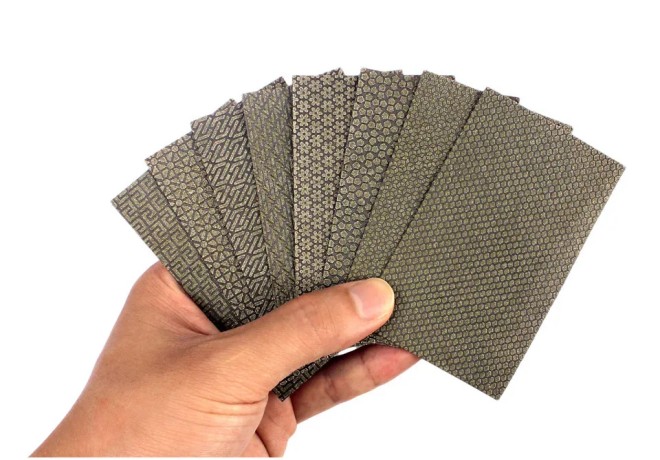When it comes to creating perfectly smooth and rounded edges on stone surfaces, the use of burrs has become one of the most widely adopted techniques. This method provides a reliable solution for professionals seeking to achieve the perfect polish on stone, taking into account factors such as thickness and overall grinding effect. This article takes an in-depth look at stone rounding techniques and explains the different methods and their pros and cons.
Grinding head for rounding edges
The power of grinding head: Utilizing a round grinding head, professionals can effectively grind the stone to create a smooth and rounded edge. This technology has gained widespread popularity due to its versatility and ability to meet various project requirements. The grinding head is specially designed to provide precision, ensuring every edge is perfectly rounded and beautiful. When the thickness of the stone is moderate, using a grinding head to round the edges of the stone is most effective. This ensures that the grinding process effectively smoothes the edges without affecting the structural integrity of the stone.
Hand rounded edges
Manual rounding accuracy: Operators use tools such as wire brushes, sandpaper, and flap discs to carefully polish the rounded edges of the stone to obtain a finer grinding effect, which is especially suitable for thick stone or when pursuing high-end decorative effects. The edges of the stone surface are hand-rounded, giving the craftsman precise control over the grinding process. Using wire brushes, sandpaper, and abrasive discs, operators can carefully shape and polish stone edges to achieve superior smoothness and precision. The manual rounding method is particularly suitable for thick stones that may not be achievable with other techniques. The longer cycle times and higher costs associated with this method are justified by the ability to achieve superior results on stones with significant depth. The manual method allows craftsmen to carefully shape and refine edges, creating visually striking silhouettes and enhancing the overall beauty of the stone surface. The ability to achieve intricate details and smooth curves is a significant advantage of hand rounding, one that resonates with designers and architects aiming to create unique and eye-catching stone installations.

Mechanical rounding
Mechanical rounding refers to the process of stone processing using automated polishing machinery. This method provides a more uniform and coordinated grinding effect and can process stones of different sizes. However, it should be noted that during the mechanical grinding process, some water marks, spots and other defects may appear on the surface of the stone. After the mechanical rounding process is complete, these defects need to be corrected and addressed.
Nozzle rounded edge
Nozzle rounding is a specialized stone processing method that uses a nozzle grinder to achieve smooth and rounded edges on the stone. The process involves removing burrs and blemishes from the stone’s surface, resulting in a clean, polished surface. This method grinds extremely well and provides the stone with a high-quality edge. It’s worth noting that nozzle rounding is often used in specific applications that require rounded edges, such as construction or design projects. Due to the high cost of equipment and the specialized nature of the process, nozzle rounding may not be suitable for all stone processing needs.
Precautions:
Material quality: the basis for successful grinding Before starting any grinding process, the quality of the stone itself must be assessed to avoid any potential anomalies caused by material issues. Ensuring the stone is of high quality minimizes the risk of inconsistent grinding or poor results. Before starting the grinding process, inspect the stone thoroughly and address any flaws or weaknesses to make the operation smoother and more efficient.
Customize your approach to get the best results: In order to achieve the ideal stone-facing effect, different processing methods should be used according to specific requirements and circumstances. By carefully selecting and applying appropriate techniques, stone fabricators can effectively enhance the desired results of each project. The versatility of the approach allows for customization, giving way to a variety of stone finishes that meet individual client needs with exceptional precision.
Reinforce thicker stones to prevent shattering: Thicker stones require additional precautions to avoid shattering during grinding due to their increased weight and density. It is crucial to strengthen these stones before grinding to ensure structural integrity. By adequately supporting and reinforcing thicker stones, operators can minimize the risk of potential damage and ensure a seamless grinding experience.
Prioritize operator safety with protective equipment: Operators must wear protective equipment, especially during manual and round-edge grinding processes. Comprehensive protective equipment such as goggles, gloves, and face shields must be used to prevent injury and minimize potential accidents. Creating a safe working environment is vital to the long-term development of the stone processing industry and the well-being of its employees.
High-quality tools for efficient grinding and scratch reduction: The quality of grinding tools, including grinding heads, sandpaper, and discs, plays a key role in achieving optimal machining results. Choosing quality tools ensures an efficient and effective grinding process while minimizing unwanted marks due to wear and tear. By regularly inspecting and maintaining these tools, stone fabricators can guarantee higher results, resulting in superior stone finishes.
In conclusion, while there are many ways to round stone processing, it is crucial to choose the method that best suits your individual needs. Emphasizing safety during the grinding process is critical to protecting workers and ensuring successful results. By adhering to preventive measures, stone processors can optimize their operations, deliver superior results, and meet the changing needs of the industry.
Post time: Oct-20-2023
